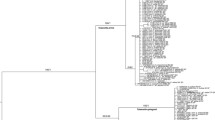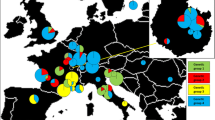Abstract
Tricholoma scalpturatum is an ectomycorrhizal fungus that forms symbioses with roots of diverse trees and shrubs. It is commonly encountered in a wide range of habitats, across temperate ecosystems. A previous study has revealed a high genetic diversity at a local scale, and ruderal abilities. To examine genetic structure at a large geographical scale, a total of 164 basidiocarps were collected from 30 populations located in Western Europe, from Spain to Scandinavia. These samples were analyzed by three molecular methods with different levels of resolution: inter-simple sequence repeats (ISSRs), restriction fragment length polymorphisms (RFLPs) in the rDNA internal transcribed spacer (ITS), and ITS sequence analysis. Considerable genetic variation was found, and the morphospecies was separated into two genetic groups that were distinct from each other. The ISSR data and the relatively low percentage value (96%) of shared sequence polymorphisms in the ITS between isolates from the two groups, strongly suggest cryptic species and long-lasting separation. No geographical exclusion was detected for these two widely distributed taxa. However, high estimates of population differentiation were observed in each group, including between populations less than a few kilometers apart. This result provides evidence for limited gene flow and/or founding effects. It also indicates that T. scalpturatum does not constitute a random mating population, and the hypothesis of endemism cannot be excluded for this cosmopolitan wind-dispersed fungus.




Similar content being viewed by others
References
Anderson MJ (2003) PCO: a FORTRAN computer program for principal coordinate analysis. Department of Statistics, University of Auckland, New Zealand
Bergemann SE, Miller SL (2002) Size, distribution, and persistence of genets in local populations of the late stage ectomycorrhizal basidiomycete, Russula brevipes. New Phytol 156:313–320
Bidartondo M, Gardes M (2005) Fungal diversity in molecular terms: profiling, identification, and quantification in the environment. In: Dighton J, White TF, Oudemans P (eds) The Fungal Community, 3rd edn. CRC Press, Boca Raton, pp 215–239
Bon M (1984) Les Tricholomes de France et de l’Europe Occidentale. Lechevalier edn., Paris
Bruns TD, White TJ, Taylor JW (1991) Fungal molecular systematics. Annu Rev Ecol Evol Syst 22:525–564
Burnett J (2003) Fungal population and species. Oxford University Press, Oxford, UK
Cho J-C, Tiedje JM (2000) Biogeography and degree of endemicity of fluorescent Pseudomonas strains in soil. Appl Environ Microbiol 60:1227–1234
Christensen M, Noordeloos ME (1999) Notulae ad floram agaricinam neerlandicam-XXXVI Tricholoma. Persoonia 17:295–317
Dettman JR, Jacobson DJ, Taylor JW (2003) A multilocus genealogical approach to phylogenetic species recognition in the model Eukaryote Neurospora. Evolution 57:2703–2720
Douhan GW, Rizzo DM (2005) Phylogenetic divergence in a local population of the ectomycorrhizal fungus Cenococcum geophilum. New Phytol 166:263–271
Dunham SM, Kretzer A, Pfrender ME (2003) Characterization of pacific golden chanterelle (Cantharellus formosus) genet size using co-dominant microsatellite markers. Mol Ecol 12:1607–1618
Excoffier L, Smouse PE, Quattro JM (1992) Analysis of molecular variance inferred from metric distances among DNA haplotypes: application to human mitochondrial DNA restriction data. Genetics 131:479–491
Finlay BJ (2002) Global dispersal of free-living microbial eukaryote species. Science 296:1061
Finlay BJ, Clarke KJ (1999) Ubiquitous dispersal of microbial species. Nature 400:828
Fisher MC, Koenig GL, White TJ, San-Blas G, Negroni R, Gutierrez Alvarez I, Wanke B, Taylor JW (2001) Biogeographic range expansion into South America by Coccidioides immitis mirror new world patterns of human migration. Proc Natl Acad Sci USA 98:4558–4562
Garcia-Pichel F, Prufert-Bedout L, Muyer G (1996) Phenotypic and phylogenetic analyses show Microcoleus chthonoplastes to be a cosmopolitan cyanobacterium. Appl Environ Microbiol 62:3284–3291
Gardes M, Bruns TD (1993) ITS primers with enhanced specificity for basidiomycetes—application to the identification of mycorrhizae and rusts. Mol Ecol 2:113–118
Grubisha LC, Bergemann SE, Bruns TD (2007) Host islands within the California Northern Channel Islands create fine-scale genetic structure in the two sympatric species of the symbiotic ectomycorrhizal fungus Rhizopogon. Mol Ecol 16:1811–1822
Gryta H, Carriconde F, Charcosset J-Y, Jargeat P, Gardes M (2006) Population dynamics of the ectomycorrhizal fungal species Tricholoma populinum and Tricholoma scalpturatum associated with black poplar under differing environmental conditions. Environ Microbiol 8:773–786
Hall TA (1999) BioEdit software, version 5.0.9. North Carolina State University, Raleigh, NC
Hantula J, Dusabenygasani M, Hamelin RC (1996) Random amplified microsatellites (RAMS)—a novel method for characterizing genetic variation within fungi. Eur J For Path 26:159–166
Hawksworth DL (2001) The magnitude of fungal diversity: the 1.5 million species estimate revisited. Mycol Res 105:1422–1432
Horton TR, Bruns TD (2001) The molecular revolution in ectomycorrhizal ecology: peeking into the black-box. Mol Ecol 10:1855–1871
Izzo A, Agbowo J, Bruns TD (2005) Detection of plot-level changes in ectomycorrhizal communities across years in a old-growth mixed-conifer forest. New Phytol 166:619–630
Jacobson DJ, Dettman JR, Adams RI, Boesl C, Sultana S, Roenneberg T, Merrow M, Duarte M, Marques I, Ushakova A, Carneiro P, Videira A, Navarro-Sampedro L, Olmedo M, Corrochano LM, Taylor JW (2006) New findings of Neurospora in Europe and comparisons of diversity in temperate climates on continental scales. Mycologia 98:550–559
James TY, Porter D, Hamrick JL, Vilgalys R (1999) Evidence for limited intercontinental gene flow in the cosmopolitan mushroom, Schizophyllum commune. Evolution 53:1665–1667
Kasuga T, White TJ, Koenig G, Mcewen J, Restrepo A, Castaneda E, Da Silva Lacaz C, Heins-Vaccari EM, De Freitas R, Zancopé-Oliviera RM, Qin Z, Negroni R, Carter DA, Mikami Y, Tamura M, Taylor ML, Miller GF, Poonwan N, Taylor JW (2003) Phylogeography of the fungal pathogen Histoplasma capsulatum. Mol Ecol 12:3383–3401
Kauserud H, Stensrud Ø, DeCock C, Shalchian-Tabrizi K, Schumacher T (2006) Multiple gene genealogies and AFLPs suggest cryptic speciation and long-distance dispersal in the basidiomycete Serpula himantioides (Boletales). Mol Ecol 15:421–431
Kõljalg U, Larsson K-H, Abarenkov K, Nilsson RH, Alexander IJ, Eberhardt U, Erland S, Høiland K, Kjøller R, Larsson E, Pennanen T, Sen R, Taylor AFS, Tedersoo L, Vrålstad T, Ursing BM (2005) UNITE: a database providing web-based methods for the molecular identification of ectomycorrhizal fungi. New Phytol 166:1063–1068
Koufopanou V, Burt A, Szaro T, Taylor JW (2001) Gene genealogies, cryptic species, and molecular evolution in the human pathogen Coccidioides immitis and relatives (Ascomycota, Onygenales). Mol Biol Evol 18:1246–1258
Mantel NA (1967) The detection of disease clustering and a generalized regression approach. Cancer Res 27:209–220
Martin F, Delaruelle C, Ivory M (1998) Genetic variability in intergenic spacers of ribosomal DNA in Pisolithus isolates associated with pine, eucalyptus and Aflezia in lowland Kenyan forests. New Phytol 139:341–352
Martin F, Dìez J, Dell B, Delaruelle C (2002) Phylogeography of the ectomycorrhizal Pisolithus species as inferred from nuclear ribosomal DNA ITS sequences. New Phytol 153:345–357
Murat C, Diez LP, Delaruelle C, Dupré C, Chevalier G, Bonfante P, Martin F (2004) Polymorphism at the ribosomal DNA ITS and its relation to postglacial re-colonization of the Perigord truffle Tuber melanosporum. New Phytol 164:401–411
Nei M, Li WH (1979) Mathematical model for studying genetic variation in terms of restriction endonucleases. Proc Natl Acad Sci USA 76:5269–5273
Ovrebo CL (1989) Tricholoma, subgenus Tricholoma, section Albidogrisea: North American species found principally in the Great Lakes region. Can J Bot 67:3134–3152
Pringle A, Baker DM, Platt JL, Wares JP, Latgé JP, Taylor JW (2005) Cryptic speciation in the cosmopolitan and clonal human pathogenic fungus Aspergillus fumigatus. Evolution 59:1886–1899
Rubini A, Paolocci F, Riccioni C, Vendramin GG, Arcioni S (2005) Genetic and phylogeographic structures of the symbiotic fungus Tuber magnatum. Appl Environ Microb 71:6584–6589
Schneider S, Roessli D, Excoffier L (2000) ARLEQUIN ver 2.000. A software for population genetics data analysis. URL: http:/anthro.unige.ch/arlequin
Smith ME, Douhan GW, Rizzo DM (2007) Ectomycorrhizal community structure in a xeric Quercus woodland based on rDNA sequence analysis of sporocarps and pooled roots. New Phytol 174:847–863
Taylor JW, Jacobson DJ, Kroken S, Kasuga T, Geiser DM, Hibbett DS, Fisher MC (2000) Phylogenetic species recognition and species concepts in fungi. Fungal Genet Biol 31:21–32
Tedersoo L, Kõljalg U, Hallenberg N, Larsson K-H (2003) Fine scale distribution of ectomycorrhizal fungi and roots across substrate layers including coarse woody debris in a mixed forest. New Phytol 159:153–165
Thioulouse J, Chessel D, Dolédec S, Olivier J-M (1997) ADE-4: a multivariable analysis and graphical display software. Stat Comput 7:75–83
Thompson JD, Gibson TJ, Plewniak F, Jeanmougin F, Higgins DG (1997) The CLUSTAL_X windows interface: flexible strategies for multiple sequence alignment aided by quality analysis tools. Nucleic Acids Res 24:4876–4882
Tsui CKM, Sivichai S, Berbee ML (2006) Molecular systematics of Helicoma, Helicomyces and Helicosporium and their teleomorphs inferred from rDNA sequences. Mycologia 98:94–104
Turner B (1987) Two ecotypes of Neurospora intermedia. Mycologia 79:425–432
Van de Peer Y, De Wachter R (1994) TREECON for windows: a software package for construction and drawing of evolutionary trees for Microsoft Windows environment. Comp Appl Bio sci 10:569–570
Viviani MA, Cogliati M, Esposto MC, Lemmer K, Tintelnot K, Colom Valiente MF, Swinne D, Velegraki A, Velho R, Group ECoMMECW (2006) Molecular analysis of 311 Cryptococcus neoformans isolates from 30-month ECMM survey of cryptococcosis in Europe. FEMS Yeast Res 6:614–619
White TJ, Bruns TD, Lee S, Taylor J (1990) Amplification and direct sequencing of fungal ribosomal RNA genes for polygenetics. In: Innis MA, Gelfand DH, Sninsky JJ, White TJ (eds) PCR protocols: a guide to methods and applications. Academic Press, New York, USA, pp 315–322
Zhan J, Pettway RE, McDonald BA (2003) The global genetic structure of the wheat pathogen Mycosphaerella graminicola is characterized by high nuclear diversity, low mitochondrial diversity, regular recombination, and gene flow. Fungal Genet Biol 38:286–297
Zhu H, Higginbotham KO, Dancik BP (1988) Intraspecific genetic variability of isozymes in the ectomycorrhizal fungus Suillus tomentosus. Can J Bot 66:588–594
Acknowledgments
We thank Dr. Darin Penneys and Dr. Wieland Meyer for critical review of the manuscript and Dr. Lounès Chikhi for advices and suggestions during the course of the project. We also gratefully acknowledge Dr. Pierre-Arthur Moreau, Jacques Fournier, Marie Fournier, and Pr. Guy Durrieu for assistance with collecting, Sophie Manzi and Nicolas Paoli for technical assistance in the molecular analysis. Funding for this research was provided by a MENRT grant “ACI Microbiologie” to M.G.
Author information
Authors and Affiliations
Corresponding author
Rights and permissions
About this article
Cite this article
Carriconde, F., Gardes, M., Jargeat, P. et al. Population Evidence of Cryptic Species and Geographical Structure in the Cosmopolitan Ectomycorrhizal Fungus, Tricholoma scalpturatum . Microb Ecol 56, 513–524 (2008). https://doi.org/10.1007/s00248-008-9370-2
Received:
Revised:
Accepted:
Published:
Issue Date:
DOI: https://doi.org/10.1007/s00248-008-9370-2




